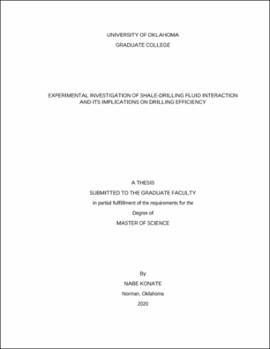| dc.description.abstract | The United States (US) energy consumption is growing at an amazing rate. The high demand in oil and gas has created a surge in shale exploration, drilling, and production. Shale formations have become a source of attraction because of their huge potential. Some major shale plays such as the Tuscaloosa Marine Shale (TMS) have reserve estimated to be more than seven (7) billion barrels. Despite their huge potential, shale formations present major drilling concerns for drilling operators due to their high rate of alteration and incompatibility when exposed to inappropriate drilling or completion fluid systems. Shale instability and low drilling rate represent some of primary drilling concerns encountered in most shale formations.
Wellbore instability is caused by the radical change in the mechanical strength as well as chemical and physical alterations when exposed to drilling fluids. A set of unexpected events associated with wellbore instability in shales account for more than 10% of drilling cost, which is estimated to one billion dollars per annum. Understanding shale-drilling fluid interaction plays a key role in minimizing drilling problems in unconventional resources. Drilling operators are moving away from conventional water-based mud systems because of the concerns associated with it. Therefore, the need for an alternative drilling fluid system for drilling operations in unconventional resources is growing. Oil-based mud systems have been widely used, but stringent environmental regulations and cost limit their effectiveness, therefore the introduction of inhibitive mud systems for shale operations. The introduction of inhibitive mud systems in shale drilling provide a means of controlling instability and improving drilling efficiency. The shale fluid interaction is mainly influenced by both the shale properties (mineralogy, shale strength, porosity, and permeability), and the drilling fluid properties (rheology, cutting removal abilities, and drilling effectiveness).
The novelty in this research includes the use of an innovative high-pressure high-temperature drilling simulator set up to investigate both the drilling performance and the compatibility of a set of inhibitive mud systems used in shale drilling. The effectiveness of these inhibitive mud systems in improve shale drilling operation was investigating in the Tuscaloosa Marine Shale (TMS). The tested mud systems included KCl based fluid, formate brine, and conventional water-based mud (WBM). Cylindrical cores, used to mimic vertical wellbore, were drilled and drilling parameters such as torque, friction factor, rate of penetration (ROP), and mechanical specific energy (MSE) were recorded and analyzed. | en_US |
